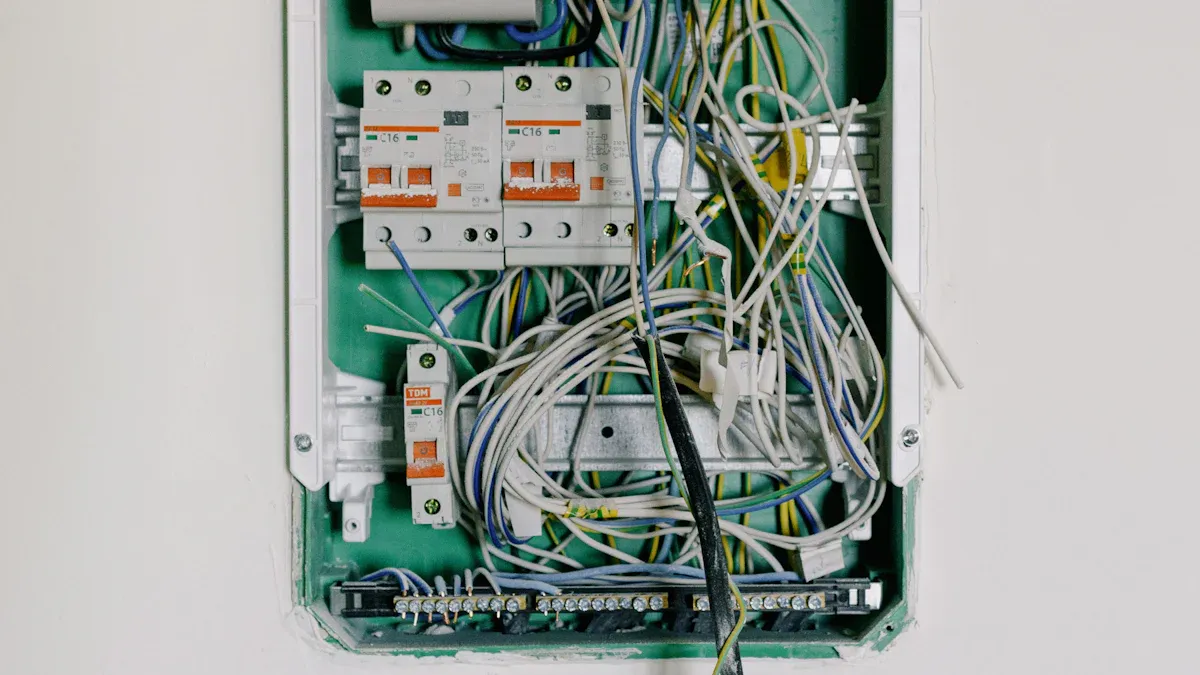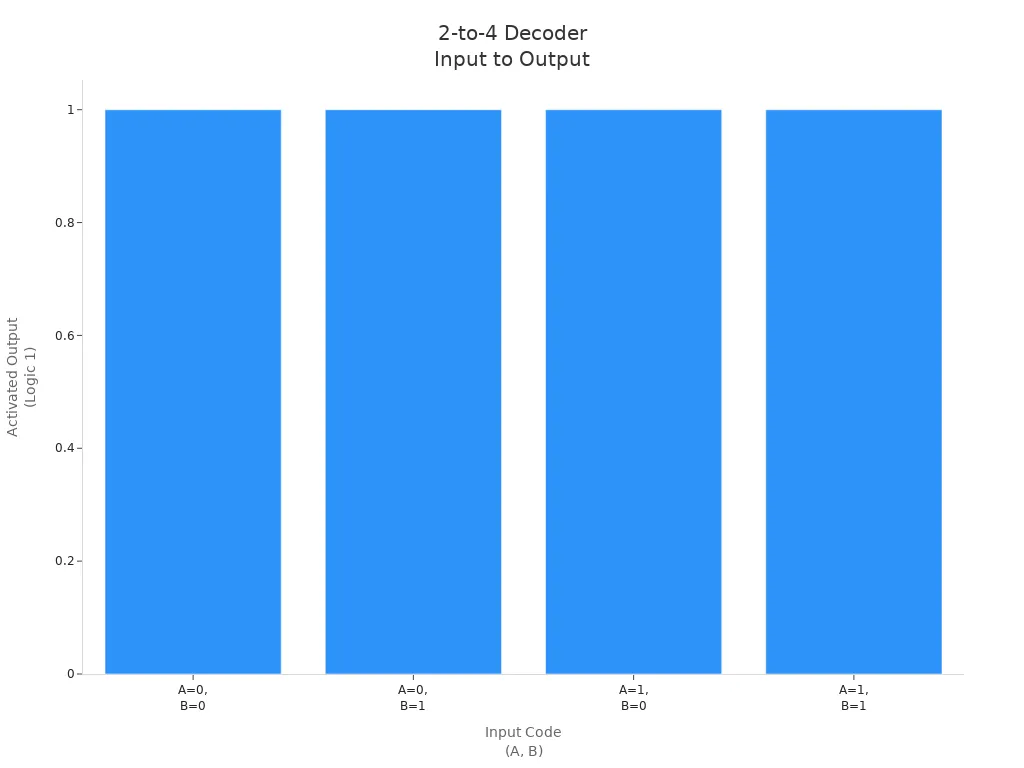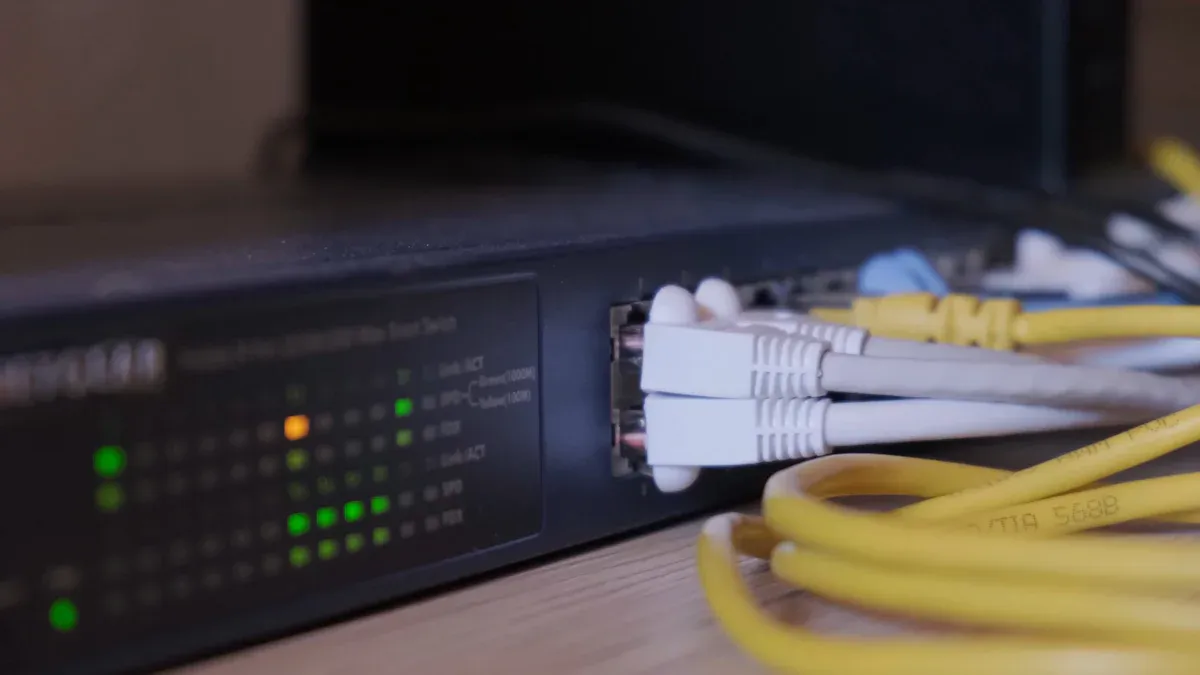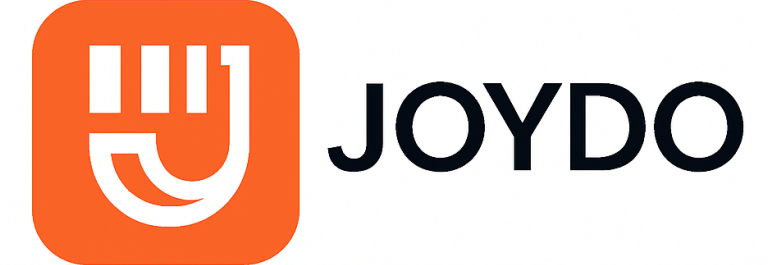What is a Decoder and How Does It Work
A decoder is a logic circuit. It takes coded input signals and changes them into coded output signals. You use a decoder to turn numbers or signals into a special output.This process helps information move safely and correctly in digital systems. For example, advanced decoders in the Right Chip or Joydo Electronic Chip use smart ways to fix errors and protect your data. These circuits use binary math and signal processing.They make sure you get the right information every time. This happens when you use a phone, watch TV, or send messages.
Decoder Basics

Image Source: pexels
What Is a Decoder
A decoder is a special digital circuit. It helps you figure out coded information. This circuit takes binary input signals. It changes them into a single output. Each input set matches one output. You see this in devices that pick one choice from many. For example, it helps choose a memory spot in a computer.
A decoder is a combinational logic circuit. Its output depends only on the current input. It does not care about past inputs.A decoder uses logic gates like AND, OR, and NOT. These gates make sure only one output turns on for each input. You can see this when you use a calculator or a digital clock.
Main Function
The main job of a decoder is to change coded inputs into single outputs. You give the decoder a binary code. It turns on one output line that matches your input. For example, with two input lines, the decoder has four outputs. Only one output is on at a time. This depends on your input.The number of inputs and outputs follows a simple rule. If you have 'n' input lines, you get 2^n outputs. For example, three inputs give you eight outputs. This rule helps you build circuits that pick one choice from many.
A decoder does the opposite of an encoder. An encoder takes many inputs and makes fewer outputs. A decoder takes a few inputs and makes many outputs. This one-to-one match makes sure each input gets its own output.You use decoders in memory, displays, and control circuits. They help you pick data, run displays, and manage signals in digital devices.
How Decoders Work
Input and Output
You can think of a decoder as a smart switch. It takes a set of binary input signals and turns on only one output line at a time. Each input code matches exactly one output. This process helps you select a specific device, memory location, or function in a digital system.A decoder uses logic gates to read your input code. It then activates the output line that matches your code. All other outputs stay off. This is called "one-hot" output because only one output is high (logic 1) at any moment.
When you use a decoder, you control which output line becomes active by changing the input code. This makes it easy to manage many devices with just a few input lines.Digital decoders work with specific voltage levels. These levels depend on the logic family used in your circuit. You can see that each logic family has its own voltage rules for what counts as a "high" or "low" signal. This helps your decoder work correctly with other parts of your circuit.
2-to-4 Decoder
A 2-to-4 decoder is a simple but powerful circuit. You give it two binary inputs. It gives you four outputs. Only one output is active at a time. This matches the input code you provide.
You can also use an enable input (E) to control when the decoder works. When E is 0, all outputs are off. When E is 1, the decoder responds to the inputs.Each unique input combination with enable active turns on only one output. This makes the 2-to-4 decoder perfect for selecting one device out of four.
You will find 2-to-4 decoders in many digital circuits. Here are some common uses:
Memory Addressing: You can use a decoder to pick a specific memory cell.
Logic Function Implementation: You can build logic functions by connecting decoder outputs to other gates.
De-Multiplexing: You can route one signal to several outputs, one at a time.

3-to-8 Decoder
A 3-to-8 decoder works like a bigger version of the 2-to-4 decoder. You give it three binary inputs. It gives you eight outputs. Only one output is active for each input code. This lets you control up to eight devices or memory locations with just three wires.
When you set the enable input high, the decoder checks the three input bits and activates the matching output. If enable is low, all outputs stay off. This feature helps you control when the decoder works.A popular example is the 74LS138 chip. You can use it for memory address decoding and data routing. This chip makes your circuit simpler and more reliable. It has features like noise resistance, low power use, and static protection.
You can use it to select memory locations, control devices, or build larger digital systems.
Simplification: You reduce the number of wires and logic gates needed.
Flexibility: You can control many devices with just a few inputs.
Modularity: You can connect several decoders to handle even more outputs.
Reliability: You use proven, simple parts that work well together.
Memory Address Decoding: You select specific memory chips or areas with ease.
With a 3-to-8 decoder, you can manage complex digital systems with less effort and greater accuracy.
Decoder Types
Binary Decoder
A binary decoder is used a lot in digital circuits. It takes binary inputs and gives one special output. If you have two input bits, you get four outputs. Only one output is on at any time. Line decoders use this to pick one device from many. This saves wires.
The circuit uses AND and NOT gates to make sure only the right output is on. An enable input lets you turn the decoder on or off. This setup makes binary decoders easy to use and dependable. You can use them for logic functions or picking memory spots.A binary decoder turns on just one output for each input set. This helps you control devices or memory in your projects.
BCD to 7-Segment
A BCD to 7-segment decoder helps show numbers on digital screens. You give it a 4-bit BCD input. The decoder lights up the right parts of a 7-segment display. This shows numbers from 0 to 9. Here is what happens:
You enter a 4-bit BCD code (A, B, C, D).
The decoder changes this code into seven signals, one for each segment (a–g).
Each output goes to a segment on the display.
The decoder cuts down the number of wires from seven to four.
You use current limiting resistors to keep the LEDs safe.
Chips like the 4511 and 7447 are often used for this.
You can use this decoder with both common anode and common cathode displays. It helps you make clocks, calculators, and counters that show numbers clearly.
Address Decoder
An address decoder helps you pick a certain memory chip or device in a computer. When the processor sends an address, the decoder checks it. It then turns on the right chip select or enable signal.This means only one memory spot is used at a time. Address decoders are important in memory-mapped systems. They make sure each device or memory area has its own place in the address space.
You see address decoders in microprocessor systems. They help control many memory chips that look the same but have different addresses.Address decoders are special because they pick memory or devices using address lines, not just simple binary codes.
Other Types
There are many special decoders in advanced digital systems. Some decoders find special signals, like FSK or PSK, in communication systems. Others, like video decoders, change digital video data into signals for TVs.These decoders may have extra features like signal checking, error finding, or support for different video types. For example, some video decoders work with NTSC and PAL formats, add closed captions, or handle color signals. You use these decoders in TV stations, studios, and home electronics.
Applications

Image Source: pexels
Computers and Memory
Decoders are used in computers and digital devices. In a computer, a decoder helps the processor pick the right memory spot. When you open a file, the processor sends a code. The decoder reads this code and turns on the correct memory chip.
This makes sure your data goes to the right place. Decoders also help microprocessors turn codes into control signals. These signals tell the computer what to do next. Decoders make these choices fast and correct. This helps computers work faster and use less power.
Displays and Interfaces
Decoders are important for digital screens and controls. When you look at a clock or calculator, you see numbers on the screen. The decoder takes binary codes and makes signals for the display.
This lights up the right parts so you can read numbers. In video systems, special decoders get video signals and decode them. They send clear pictures to your TV or monitor. This lets you see sharp images and smooth video on big screens. Without decoders, digital devices could not show information you can understand.
Communication Systems
Decoders help you get the right data in communication systems. When you send a message, the signal can get noise. The decoder checks the signal and fixes mistakes.Modern systems use smart ways to decode. Some decoders work in steps, first getting the main message, then adding details. Others use special algorithms like Viterbi or LDPC to fix errors. These methods help your calls, texts, and internet data stay clear, even with weak signals.
Everyday Uses
You find decoders in many things at home. When you use a remote, a decoder reads your button press. It sends the right command to your TV. Digital clocks and meters use decoders to show numbers.
Security systems use decoders to check sensors and turn on alarms. Smart door locks use decoders to unlock or lock the door.You use decoders every day, even if you do not notice. They help your devices work well and show you the right information.You use decoders all the time, even if you do not notice. Decoders change coded signals into information you can understand. These circuits help your devices pick memory and fix mistakes.
They also make sure your music and videos play smoothly at home. As technology gets better, decoders become smarter and use less energy. They help with new things like AI and 5G. When you call someone, watch a movie online, or chat with a computer, decoders are working for you.The next time you use your favorite gadget, think about how a decoder helps it work.
FAQ
What is the difference between a decoder and an encoder?
A decoder takes a small number of input lines and activates one output. An encoder does the opposite. You use a decoder to select outputs. You use an encoder to combine inputs into a code.
Why do you need an enable input on a decoder?
The enable input lets you turn the decoder on or off. When you set enable to off, all outputs stay inactive. This helps you control when the decoder works in your circuit.
Can you connect more than one decoder together?
Yes! You can connect decoders to handle more outputs. For example, you can use two 3-to-8 decoders to make a 4-to-16 decoder. This method helps you build larger systems.
Where do you see decoders in real life?
You see decoders in TVs, computers, calculators, and remote controls. They help show numbers, pick memory spots, and read signals from buttons.









